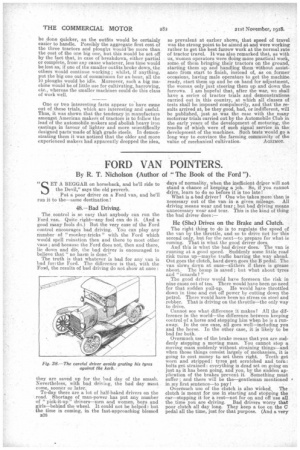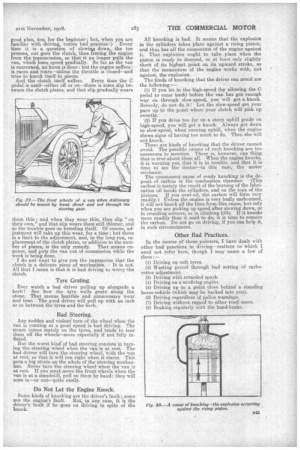FORD VAN POINTERS.
Page 18

Page 19

If you've noticed an error in this article please click here to report it so we can fix it.
By R. T. Nicholson (Author of "The Book of the Ford ").
"SET A BEGGAR on horseback, and he'll ride to the Devil," says the old proverb. Put a poor driver on a Ford van, and he'll run it to the—same destination!
48.—Bad Driving.
The, control is so easy that anybody can run the Ford van. Quite. right—any fool can do it. (And a good many fools do.) But the very ease of the Ford control encourages bad driving. You can play any number of " monkeyAricks " with the Ford which would spell ruination then and there to most other vans ; and because the Ford does not, then and there, lie down and die, the bad driver is encouraged to believe that "no harm is done," The truth is that whatever is bacl for any van is bad fon the Ford. The difference is that, with the Fosd, the results of bad driving do not show at once : they are saved up for the had day of the smash. Nevertheless, with bad driving, the bad day mast come, sooner or later.
To-dais there are a lot of half-baked drivers on the road. shortage of man-power has put any number of "pick-it-up" -drivers—men and women, boys and girls—behind the wheel. It could not be helped : but the time is coming, in the fast-approaching blessed
B38 days of normality, when the inefficient driyer will not stand a chance of keeping a job, So, if you cannot drive, learn to do so before it is too late ! What is a bad driver I One who takes more than is necessary out of the van in• a given mileage. All driving means wear and tear ; but bad driving means unnecessary wear and tear. This is the kind of thing the bad driver does:—
He (She) Drives on the Brake and Clutch.
The right thing to do is to regulate the speed of the van by the throttle, and so to drive not for this second only, but for the next—to prepare for what is coming. That is what the good driver does.
And this is what. the •bad driver does. The van is running at a good speed. Suddenly some little road risk turns up—maybe traffic barring the way ahead. Out goes the clutch, hard down goes the B pedal. The van slows down at once—slithers if there is grease absnit. The 'bump is saved: but what about tyres and " innards ? "
The good driver would have foreseen the risk in nine cases out of ten. There would have been no need for that sudden pull-up. Ile would have throttled down in time and cut off power by cutting down the petrol. There would have beers no stress on steel and rubber. That is driving on the throttle—the only way to drive.
Cannot see what difference it makes? All the difference in the world—the difference between keeping control of a horse and stopping him when he is a runaway. In the one case, all goes well—including you and the horse. In the other case, it is likely to he bad for both.
Overmuch use of the brake means that you are suddenly stopping a moving mass. You cannot stop a moving mass suddenly without straining things—and when those things consist largely of mechanism, it is going to cost money to set them right. Teeth get worn and stripped : tyres get scratched and torn: bolts get strained : everything is dead set on going on just as it has been going, and you, by the sudden application of the brakes prevent it. Something must suffer ; and there will be the—gentleman mentioned * in my first sentence—to pay!
Overmuch use of the clutch is also wicked.. The clutch is meant for use in starting and stopping the car—stopping it for a rest—not for on and off use all the time you .are driving. Bad drivers worry that poor clutch all day long. They keep a toe on the C pedal all the time, just for that purpose. (And a very good plan, too, for the beginner ; but, when you are familiar withdriving, rotten bad practice !) Every time it is a question of slowing down, the toe presses, out goes the clutch, thus freeing the engine from the transmission, so that it no longer pulls the van, which loses speed gradually. So far as the van is concerned, no harm is done: but the engine suffers: it races and roars—unless the throttle is closed—and tries to knock itself to pieces. And the clutch itself suffers. Every time the C pedal is used—either off or on—there is some slip between the clutch plates, and that slip gradually wears them thin ; and when they wear thin,. they slip "on their own," and that slip wears them still thinner, and so the trouble goes on breeding itself. Of course, adjustment will take up this wear, for a time ; but there is a limit et:, the adjustment, and, in the long run, replacement of the clutch plates, or addition to the number of plates, is the only remedy. That means expense, and puts the van out of commission while the work is being done. I do not want to give you the impression that the clutch is a delicate piece of mechanism. It is not. All that I mean is that it is bad driving to worry the clutch.
Tyre Grating.
Ever watch a bad driver pulling up alongside a kerb ? See how the tyre walls grate along the stone. That means horrible and unnecessary Wear and tear. The good driver will pull up with an inch or so between the tyres and the kerb.
Bad Steering.
Any sudden and violent; turn of the wheel when the van is running at a good speed is bad driving. The strain comes mainly on the tyres, and tends to tear them off the wheels—more especially if not fully inflated.
But the worst kind ofbad steering consists in turning the steering wheel when the van is at rest. The bad driver will turn the steering wheel, with the van at rest, so that it will run right when it starts. This puts a big strain on the whole of the steering mechanism. Never turn the steering wheel when the van is at rest. If you must move the front wheels when the van is at a standstill, pull on them by hand: they will nose in—or out—quite easily.
Do Not Let the Engine Knock.
Some kinds of knocking are the driver's fault ; some are the engine's fault. But, in any case, it is the driver's fault if he goes on driving in spite of the knock. All knocking is bad. It means that the explosion in the cylinders takes place against a rising piston, and thus has all the momentum of the engine against i. That explosion ought to take place when the piston is ready to descend, or at least only slightly short of its highest point on its upward stroke, so that the momentum of the engine works with, not against, the explosion. The kinds of knocking that the driver can avoid are the following:— (1) If you let in the high-speed (by allowing the C pedal to come back) before the van has got enough Way on through. slow-speed, you will get a knock. Remedy, do not do it! Let the slow-speed get your pace up to the point where your clutch will pick up sweetly. (2) If you drive too far on a steep uphill grade on high-speed, you will get a knock. Always get down to slow-speed, when running uphill, when the engine shows signs of having too much to do. Then she will not knock.
There are kinds of knocking that the driver cannot avoid. The possible causes of such knocking are too numerous to mention. There is, however,. one thing that is true about them all. When the engine knocks, it is warning you that it is in trouble, and that it is time to see the doctor—in this case, the motor mechanic.
The commonest cause of ready knocking is the deposit of carbon in the combustion chamber. (This carbon is mainly the result of the burning of the lubrication oil inside the cylinders, and on the tops of the pistons. If you over-oil, the carbon will form very readily.) Unless the engine is very badly carbonized, it will not knock all the time from this cause, but. only when you are picking up speed after slowing down, or in rounding corners, or in climbing hills. ft it knocks more readily than it used to do, it is time to remove the carbon. Do not go on driving, if you can help it, in such circumstances.
Other Bad Practices.
In the course of these pointers, I have dealt with other bad practices in driving—matters to which I need not refer here, though I may name a few of them : (1) Diliving on soft tyres. (2) Wasting petrol through bad setting of carburetter adjustment. (a) Driving with retarded spark.
(4) Driving on a misfiring engine. (5) Driving up to a point close behind a standing horse-vehicle (which may be backed into you): (6) Driving regardless of police warnings. (7) Driving without regard to other road users.
(8) Braking regularly with the hand-brake.






















